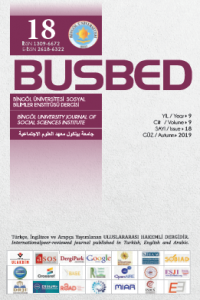TÜRKÇEDE SES TÜREMESİ – ORHUN YAZITLARINDAN EVLİYA ÇELEBİ SEYAHATNAMESİNE KADAR –
SOUND REPRODUCTİON IN TURKISH -FROM ORKHON INSCRIPTIONS TO EVLİYA ÇELEBİ’S “SEYAHATNAME”-
Author(s): Veysi Sevinçli, Süphan ÇiçekSubject(s): Phonetics / Phonology, Semantics, Turkish Literature, Turkic languages
Published by: Bingöl Üniversitesi Sosyal Bilimler Enstitüsü
Keywords: The distinction of sound; the vowel genre; consonant derivation; Orkhon inscriptions; Evliya Çelebi Travelogue;
Summary/Abstract: The language, which is a living entity, changes and develops in the process to meet the needs of its users. In addition to the changes in language itself, interactions in political, cultural, scientific and commercial fields are inevitably reflected in the language. The changes in sound, morphology, vocabulary and syntax affect the sound structures first. As a result of this effect, certain sound events such as sound reproduction, sound drop, and sound change occur for various reasons. In our study, the reasons of the sound descriptors in historical texts were taken from various angles and the samples were taken from these texts and their sounds were classified according to their positions. Basically, the pre-sound, internal sound and sound we examined in the final sound are subdivided according to their characteristics and subjected to a detailed examination. It was focused on the examples how Turkish has been affected by the languages such as Chinese, Sanskrit, Persian and Arabic with all of whom Turkish has a deep relationship throughout history. In the conclusion section, taking into account the examples, historical commentaries were made as far as possible, and frequently derived sounds were mentioned. The main reasons for the sound derivations are the shortening of the long vowels in the process, the accentuated pronunciations, and vocabulary of the words and the deterioration of the lip synchronization. In historical texts, the distinctions in the front sound and the last sound are less, while the distinction in the inner sound is higher. In the historical texts, the sound derivations are seen in the prepositions and some attachments as seen in the names and verbs. The most common sound reproduction in the annexes and prepositions is the reinforcement function and does not create any change of meaning. The sound reproduction is mostly done in foreign words in order to improve the sound system of Turkish and to make it easier to say “ı, i, u, ü” vowels; accepted semivowels “y” and also the “h” noise that generated by friction is used more.
Journal: Bingöl Üniversitesi Sosyal Bilimler Enstitüsü Dergisi (BUSBED)
- Issue Year: 9/2019
- Issue No: 18
- Page Range: 1233-1272
- Page Count: 40
- Language: Turkish

